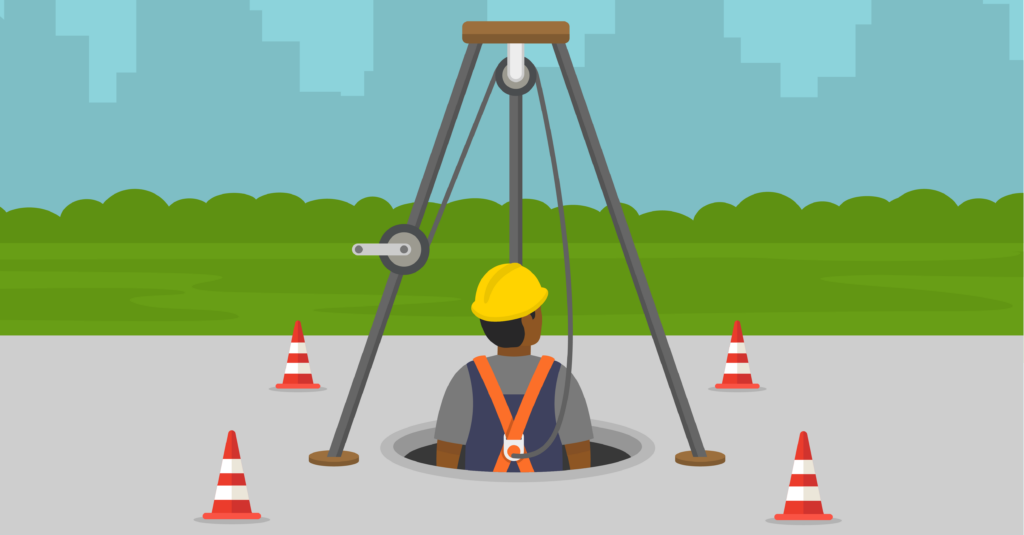Confined Space Safety: Reducing Risks and Ensuring Compliance
July 23, 2024

Confined spaces are a common yet often overlooked aspect of many industries, from construction to agriculture. Ensuring safety in these environments is crucial due to the unique risks they present. This guide explores the importance of confined spaces safety, the associated risks, relevant regulations, best practices and describes how you can maintain compliance and enhance safety management.
Importance of Confined Spaces Safety
A confined space is defined as any area large enough for an employee to enter and perform assigned work but has limited or restricted means for entry or exit and is not designed for continuous occupancy. Examples include storage tanks, silos, underground vaults and pipelines. Ensuring safety in confined spaces is vital due to the high-risk nature of these environments. The potential for serious injury or death necessitates stringent safety protocols and regular training.
From 2011 to 2018, 1,030 workers died from occupational injuries involving a confined space in the U.S.. This statistic highlights the critical need for rigorous safety measures and compliance with regulations to prevent further tragedies.
As an example, in March 2023, a 19-year-old worker tragically lost his life after being crushed inside a concrete mixer that restarted unexpectedly. OSHA cited the company for willfully exposing workers to such hazards without following necessary safety protocols. Another incident in Oklahoma City involved a worker who died from asphyxiation in a water tank after his employer failed to evaluate the tank for hazardous conditions or provide adequate safety measures.
Associated Risks in Confined Spaces
Confined spaces present several significant risks that vary across different industries.
In construction, confined spaces such as manholes, crawl spaces and tanks pose various risks:
- Suffocation: Workers may encounter low oxygen levels due to inadequate ventilation. A construction worker might suffocate while working in a poorly ventilated manhole.
- Toxic Atmospheres: Exposure to hazardous fumes from welding or solvents can lead to serious health issues. Workers might be hospitalized due to inhalation of toxic fumes while working in a confined sewer system.
- Fires and Explosions: Flammable gases from leaking pipelines can cause explosions. An explosion during a pipeline construction project could lead to fatalities.
- Physical Hazards: The risk of entrapment from collapsing structures or falling objects is significant. A worker could be crushed by a collapsing trench wall.
Similarly, confined spaces in manufacturing, such as vats, silos and storage tanks, present unique risks:
- Suffocation: Oxygen-deficient environments can occur due to chemical reactions. Workers could suffocate in a nitrogen-filled tank.
- Toxic Atmospheres: Chemical manufacturing often involves toxic substances. Workers might be exposed to lethal levels of hydrogen sulfide while cleaning a tank.
- Fires and Explosions: Combustible dust can cause explosions. A sugar refinery explosion caused by combustible dust is a real possibility.
- Physical Hazards: Moving machinery parts can pose entrapment risks. A worker might lose a limb after being trapped in a confined space with unguarded machinery.
| Type of confined space | Fatalities |
|---|---|
| Tank, bin, vat interiors | 205 |
| Silo, grain bin interiors | 107 |
| Septic tank or water tank interiors | 19 |
| Hopper interiors | 10 |
| Oil storage tank interiors | 7 |
| Grain elevator interiors | 6 |
| Trash bin or dumpster interiors | 3 |
| Ditches, channels, trenches, excavations | 203 |
| Underground mines, caves, tunnels | 129 |
| Sewers, manholes, storm drains | 61 |
| Underground mines, mine tunnels | 58 |
| Confined spaces on vehicles | 45 |
| Tanker truck interiors | 20 |
| Manure pits | 18 |
| Crawl spaces | 13 |
| Wells, cisterns | 10 |
Regulations for Confined Spaces Safety
Various regulations govern confined spaces safety across different regions. In the US, the Occupational Safety and Health Administration (OSHA) has established specific standards for confined spaces to ensure worker safety. The 29 CFR 1910.146 standard applies to general industry and outlines the requirements for permit-required confined spaces, including the need for hazard identification, proper entry procedures, and emergency rescue plans. Additionally, 29 CFR 1926 Subpart AA covers confined space safety in the construction industry, addressing similar safety measures and requirements specific to construction sites.
In the United Kingdom, the Confined Spaces Regulations 1997 mandate the identification, assessment, and control of risks in confined spaces. These regulations require employers to conduct thorough risk assessments, implement appropriate control measures and ensure that workers are adequately trained and equipped to work safely in confined spaces. The regulations also emphasize the importance of emergency procedures and rescue plans.
The European Union’s Directive 89/391/EEC on health and safety at work provides a framework for ensuring the safety and health of workers across EU member states. While it does not specifically address confined spaces, it establishes general principles for risk assessment, hazard prevention and worker training that apply to all types of work environments, including confined spaces. Member states have their own specific regulations that align with this directive and address confined space safety.
Challenges in Confined Spaces Safety
Managing safety in confined spaces involves several challenges:
- Identifying All Confined Spaces: Ensuring every confined space is recognized and assessed is crucial. Confined spaces can be easily overlooked during site evaluations, leading to unaddressed hazards. Comprehensive site surveys and continuous monitoring are necessary to identify all confined spaces.
- Updating Safety Procedures: Keeping safety protocols current with changing regulations and best practices is a continuous process. Organizations must stay informed about regulatory updates and incorporate new safety technologies and methodologies to enhance their confined space safety procedures.
- Continuous Compliance: Maintaining adherence to all relevant regulations is challenging, especially for large organizations operating in multiple jurisdictions. Implementing robust compliance tracking systems and regular audits can help ensure continuous compliance with confined space safety regulations.
- Effective Emergency Response: Developing and practicing robust emergency and rescue procedures is essential. Confined space incidents can escalate quickly, making it critical to have well-trained emergency response teams and effective rescue plans in place. Regular drills and simulations help prepare workers for real-life emergencies.
Build a stronger safety management system with insights from our free report, “Safety Management Systems: Building a Foundation on Data.” Learn about SMS standards, key data processes, and the role of technology. Download now.
Best Practices for Confined Spaces Safety
Implementing best practices is essential to mitigate risks in confined spaces. One critical step is conducting thorough risk assessments, which involve regularly evaluating potential hazards and implementing controls. These comprehensive assessments identify specific dangers within confined spaces and inform the development of tailored safety measures. Additionally, it is vital to implement proper ventilation systems to ensure adequate airflow and prevent the accumulation of hazardous gases. Well-designed and maintained ventilation systems provide continuous fresh air, reducing the risk of toxic atmospheres and suffocation.
Continuous monitoring of atmospheric conditions using reliable detection equipment is another key practice. This involves monitoring oxygen levels and the presence of toxic gases continuously, which helps detect hazardous conditions early and allows for timely intervention.
But doing so won’t help if you don’t provide adequate training for workers. All personnel should be trained in confined spaces safety procedures and emergency responses. Training programs should cover hazard recognition, safe work practices and emergency procedures, equipping workers with the knowledge and skills needed to work safely in confined spaces.
As part of your policies, develop and practice emergency and rescue procedures. Regular drills should be conducted to prepare for potential incidents, and emergency procedures should be reviewed and practiced ensuring that workers and rescue teams are prepared to respond effectively.
Using appropriate personal protective equipment (PPE) is another important practice. Workers should be equipped with necessary PPE such as respirators, helmets, harnesses and protective clothing depending on the specific hazards present in the confined space.
Finally, establish a permit-to-work system. This system authorizes and documents all work conducted in confined spaces, ensuring that all safety measures are in place before entry. A permit-to-work system provides a structured approach to managing confined space activities, enhancing overall safety and compliance.
How Intelex Can Help
Intelex offers comprehensive EHS software solutions to enhance confined spaces safety management. These solutions are designed to address various aspects of safety management, ensuring a thorough and effective approach to mitigating risks associated with confined spaces.
- Incident Management: Intelex’s Incident Management software streamlines the reporting and investigation of incidents, ensuring timely corrective actions. By capturing detailed incident data, organizations can identify root causes and implement preventive measures to avoid future occurrences. For more information, explore the Five Things You Need to Know About Incident Management and Reporting.
- Audit Management: The Audit Management software facilitates compliance through scheduled audits and detailed reporting. This tool helps organizations maintain compliance with confined spaces safety regulations by ensuring that all safety protocols are regularly reviewed and updated. Learn more about how this software can benefit your organization by visiting the Audit Management Software page.
- Training Management: Training Management software tracks and manages the training requirements for employees, ensuring they are well-prepared for confined spaces work. This solution helps organizations provide comprehensive training programs that cover hazard recognition, safe work practices, and emergency procedures. For additional details, check out the Training Management Software.
- Permit to Work: This software manages and documents all permit-to-work activities, ensuring that all safety protocols are followed. By implementing a structured permit-to-work system, organizations can ensure that all necessary safety measures are in place before any work is conducted in confined spaces. Discover more about the Permit to Work Software.
What are the benefits of these tools?
- Centralized Data Management: Intelex provides a single platform for all safety-related data, allowing for easy access and management of critical information.
- Automated Compliance Tracking: The software keeps track of regulatory changes and compliance status, ensuring that organizations remain up-to-date with the latest safety regulations.
- Real-Time Monitoring: This feature allows for continuous monitoring of environmental conditions in confined spaces, enabling prompt detection and response to any hazardous situations.
- Enhanced Regulatory Compliance: Intelex ensures adherence to all relevant safety regulations, helping organizations avoid legal penalties and enhance their safety culture.
- Improved Efficiency in Safety Management: By streamlining processes and reducing administrative burdens, Intelex improves overall efficiency in managing confined spaces safety. This allows safety professionals to focus more on proactive safety measures and less on paperwork.
Leveraging Intelex’s EHS software solutions can significantly enhance confined spaces safety management, ensuring compliance, efficiency and the well-being of workers. For more detailed information, visit the Intelex’s EHS Incident Reporting and Management Software.
Conclusion
Maintaining safety in confined spaces is of paramount importance across various industries. By following best practices, adhering to regulations and leveraging advanced EHS solutions like those offered by Intelex, organizations can significantly reduce risks and ensure the well-being of their workers. Assess your current confined spaces safety practices and consider how Intelex can help enhance your safety and compliance efforts.






